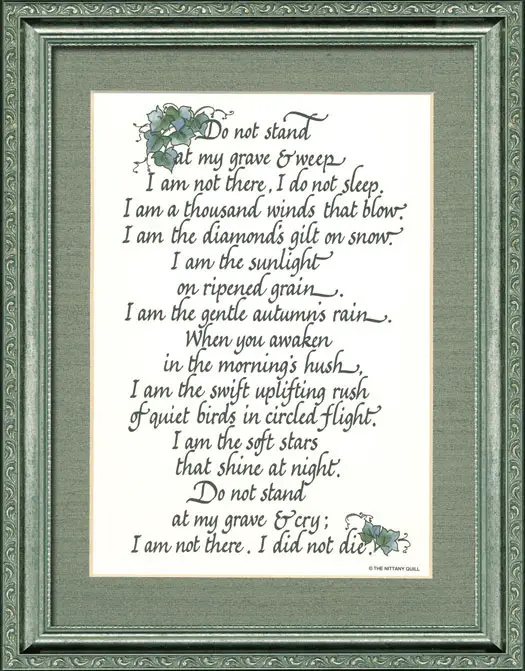

Do not stand at my grave and cry I am not there. When you awaken in the mornings hush I am the swift uplifting rush Of quiet birds in circled flight. On her death in 2004, The Times (English Newspaper) quoted a version of this poem in her autobiography. Do not stand at my grave and weep I am not there. However the mystery of the true origins of 'Do Not Stand At My Grave And Weep' seems now to have been solved when the poem was categorically attributed to Mary Frye in 1998, following research by Abigail Van. However the mystery of the true origins of "Do Not Stand At My Grave And Weep" seems now to have been solved when the poem was categorically attributed to Mary Frye in 1998, following research by Abigail Van Buren, aka Jeanne Phillips. Subsequent versions of the poems have appeared in so many places that it was firmly regarded as public domain, despite Mary Frye's claims.

Mary Elizabeth Frye (1905-2004) is an American poet who remains known today for a single poem-a sonnet of just twelve lines-but it may be the most popular poem in the English language. Subsequent versions of the poems have appeared in so many places that it was firmly regarded as public domain, despite Mary Frye's claims. The poem I chose to do a close reading essay on was, Do Not Stand At My Grave And Weep by Mary Elizabeth Frye. Later it was printed on postcards by the Schwarzkopf family and was circulated in that fashion before it was ever conventionally printed. by Mary Elizabeth Frye (1905 - 2004), 'Do not stand at my grave and weep', authentic version&emsp13 authors text checked 1 time against a primary source Musical settings (art songs, Lieder, mélodies, (etc. Mary has said she wrote it on a brown paper bag and that the words just came to her. The poet used anaphora at the beginnings of some neighboring lines. It is said that Mary wrote this for Margaret and that it was Mary's first real attempt at poetry. The author used lexical repetitions to emphasize a significant image i, not are repeated. Margaret Schwarzkopf was visiting Mary Elizabeth Frye who was living in Baltimore USA when Margaret's mother died. This is a version of a poem that, apparently was circulated as postcards printed by the Schwarzkopf family.


 0 kommentar(er)
0 kommentar(er)
